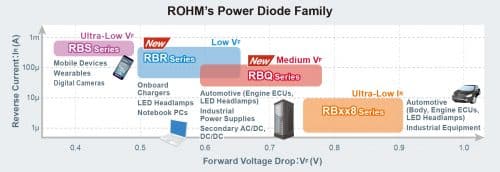ROHM has recently expanded its portfolio of Schottky barrier diodes by 24 new compact high efficiency models (12 RBR series and 12 RBQ series). These devices – 178 in total – are ideal for protection and rectification circuits in automotive, industrial equipment, and consumer applications. Diodes are commonly used in a variety of circuits for rectification and protection. Moreover, as lower power consumption is required in most applications, the adoption of SBDs – which are more efficient than other diodes – is on the rise. However, if VF is lowered to improve efficiency, IR which is inversely related to VF will become higher. This increases the risk of thermal runaway, so it is important to balance both VF and IR when selecting SBDs for circuit design.

In response, ROHM strengthened its lineup of SBDs that balances small size with low VF and IR– characteristics demanded by the automotive sector. The market-proven RBR and RBQ series have been further expanded to include a lineup of compact high current, high voltage products that enable rectification and protection in a wider range of applications. Introducing a new process allows ROHM to improve the chip performance of both series by 25% (VF of RBR series in particular) over ROHM’s conventional products. Furthermore, the RBR series features excellent low VF characteristics – key to improving efficiency and reducing loss. This makes them ideal for automotive applications as well as consumer electronics such as laptops where high efficiency is required. In fact, 12 of the products adopt a compact package (PMDE package) that reduces mounting area by 42% compared to existing products (PMDU package).
At the same time, the RBQ series delivers excellent low IR characteristics that enable stable operation in high temperature environments – significantly reducing the risk of thermal runaway which is a concern with SBDs. As such they are ideal for automotive power train applications and power supplies for industrial equipment that operate in high temperature environments. 12 new 100V products have been added to meet the need for higher voltages. And both series are qualified under the AEC-Q101 standard to ensure automotive-grade reliability.
Going forward, ROHM will continue to improve characteristics and efficiency of its semiconductor devices, from low to high voltages products while strengthening its distinctive lineup to further reduce power consumption and achieve greater miniaturisation of applications.

Key Features
In addition to adopting a new process that increases efficiency by 25% in the same chip size as ROHM’s conventional products, the RBR/RBQ series delivers the following features.
- RBR Series
1-1. Low VF reduces loss
The RBR series achieves lower loss by reducing VF by 25% compared to ROHM conventional products of the same size while suppressing IR characteristics which is at tradeoff relation with low VF. This makes them ideal for automotive applications that require higher efficiency as well as laptops and other consumer electronics where greater energy savings are required.
In addition, chip size of RBR series is reduced while maintaining performance, resulting in a smaller package that minimizes footprint. For example, replacing the conventional 3.5mm×1.6mm size PMDU (SOD-123FL) package with the new 2.5mm×1.3mm PMDE decreases mounting area by approx. 42%.
1-2. New compact package added to ROHM’s comprehensive lineup
The RBR series now includes 12 new 2.5mm×1.3mm PMDE package products (6 for consumer + 6 for automotive). This brings the total lineup to 140 products (30V/40V/60V withstand voltages, 1A to 40A current) that expands applicability to include both automotive and consumer applications.

- RBQ Series
2-1. Low IR ensures stable operation at high temperatures
The RBQ series utilizes proprietary barrier formation technology to achieve the optimum balance between VF and IR for switching power supplies. As a result, reverse power loss is decreased by 60% compared to ROHM’s conventional products, further reducing the risk of thermal runaway at high temperatures. This makes them ideal for automotive powertrain and industrial power supplies that operate in high temperature environments.
2-2. ROHM completes its lineup with new 100V products
The addition of 12 new 100V products (6 for consumer + 6 for automotive) to the RBQ series brings the total to 38 products comprised of both cathode common and single types in 45V/65V/100V withstand voltages and 10A to 30A of current.
Pricing: $1.50/unit (Samples, excluding tax)
Availability: In mass production
Application Examples
■ RBR Series
・ Automotive Applications such as LED headlamps and car accessories
・ Notebook PCs
■ RBQ Series
・ Industrial power supplies ・ Audio ・ Laptops ・ xEVs ・ Engine ECUs
・ Secondary rectification in AC/DC and DC/DC circuits
Terminology
Schottky Barrier Diodes
A type of diode that provides rectification (diode) characteristics by adopting a Schottky barrier formed through a metal-semiconductor junction. The lack of minority carrier effect results in superior high-speed performance.
Forward Voltage (VF)
A voltage drop that occurs when electricity flows from the + to the – direction. The lower this value, the higher the efficiency.
Reverse Current (IR)
Reverse current generated when reverse voltage is applied. The lower this value is, the smaller the power consumption (reverse power loss).
Thermal Runaway
When a diode is conducted in the reverse direction, heat generated within the chip may exceed the heat dissipation of the package, causing IR to increase and eventually lead to destruction, a phenomenon called thermal runaway. For SBDs with high IR values, thermal runaway is especially likely to occur, so care must be taken when designing circuits.
AEC-Q101 Automotive Reliability Standard
AEC stands for Automotive Electronics Council, an organisation (comprised of major automotive manufacturers and component makers) responsible for establishing electronic reliability standards for automotive electronics. The Q101 standard specifically applies to discrete semiconductor components (i.e. transistors and diodes).






